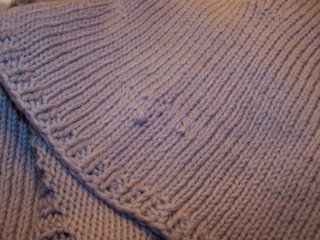Worming ends and underarm issues...
Argh. I finished it. I blocked it. (It grew a little, but seemed to pull back a little once it was completely dry, so not a fatal problem.) I wore it, and the ends that I very carefully wove in started to worm out and look all funky. Really funky. BAD funky. The picture doesn't even capture how bad it looks. 
Is anyone having issues with weaving in the ends of Cotton Fleece and having them show through? (Now I know why people hate weaving in ends on cotton.) Also, even thought the arms are not tight, the underarms are not looking so good after a wearing. Since there is very little seaming, the line of stitches where the seam would be (but isn't since it is in the round) pulled.
I guess I can go back in and reinforce with some yarn, but, ick, not what I wanted to see. I am a bit frustrated since the GG looked great after blocking and there were no hints of the problems to come!!! Advice?

Is anyone having issues with weaving in the ends of Cotton Fleece and having them show through? (Now I know why people hate weaving in ends on cotton.) Also, even thought the arms are not tight, the underarms are not looking so good after a wearing. Since there is very little seaming, the line of stitches where the seam would be (but isn't since it is in the round) pulled.

I guess I can go back in and reinforce with some yarn, but, ick, not what I wanted to see. I am a bit frustrated since the GG looked great after blocking and there were no hints of the problems to come!!! Advice?

3 Comments:
I had problems with ends coming undone on a sweater I knit with CF once. I solved it by using some Fray-Chek on the ends; you buy it at a sewing store in the notions section in a little squeeze bottle, and it stiffens the ends a bit so they don't come out.
I have washed my cotton fleece GG twice now, and I haven't had any movement of my ends. Maybe there is a difference in the way we weave our ends? I do mine on a diagonal. I found the method in Montse Stanley's book, and it works great. I have never had any problems with the ends coming out of any sweater where I used this method, come to think of it--including a baby sweater in 100% cotton, which I machine wash at least once a week. If you need more specific details for the method, let me know and I'll do better at explaining it.
It's a little too late now, but in the future to avoid the gaping at the join, use this technique:
- at the place where you join the knitting back to knit the torso, slip the stitch on the right side of the hole onto a stich holder.
- knit the next stitch
- knit the slipped stitch off the holder.
- This creates kind of a binding stitch that prevents the knitting from gaping, used a lot with mittens and things like that.
Post a Comment
<< Home